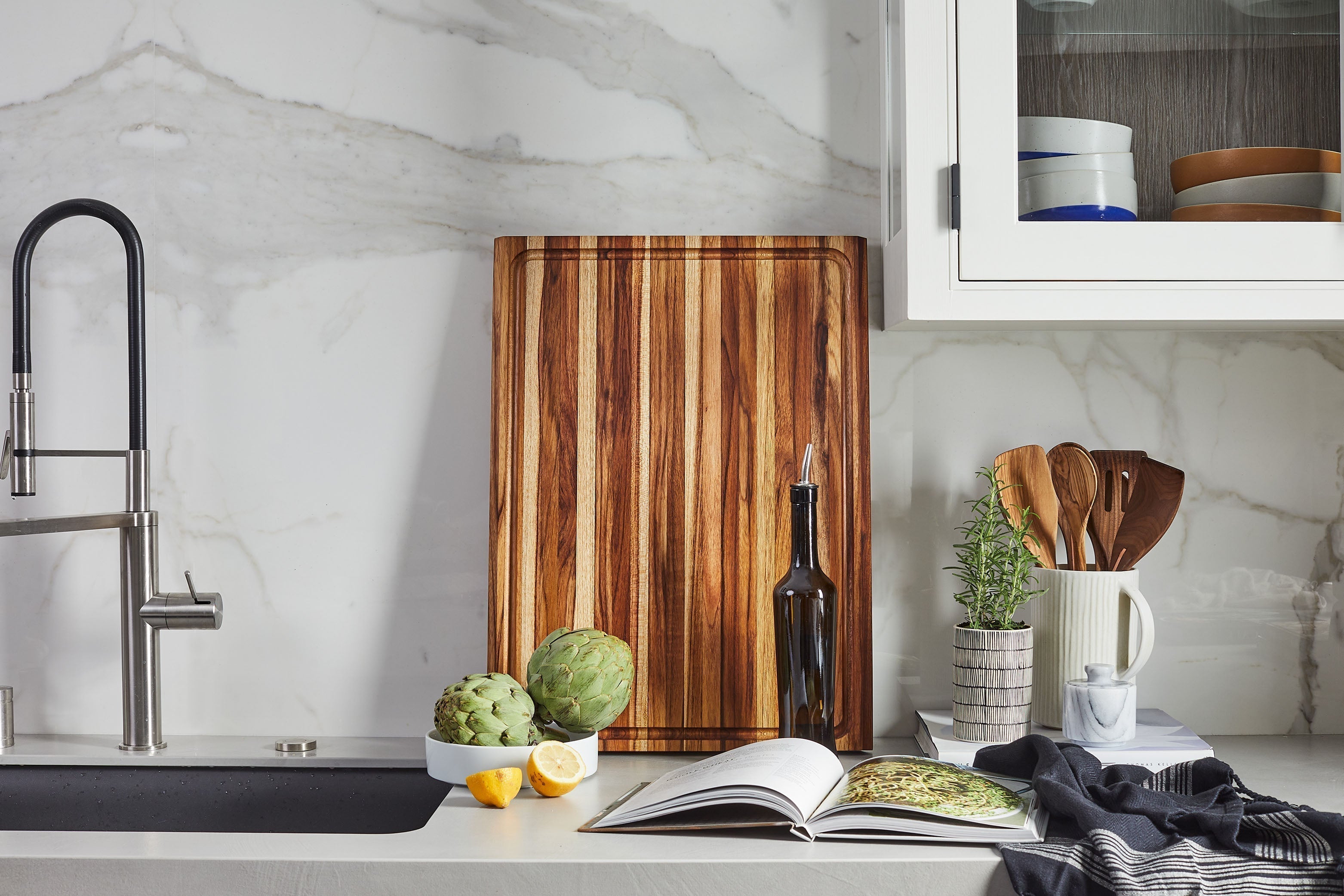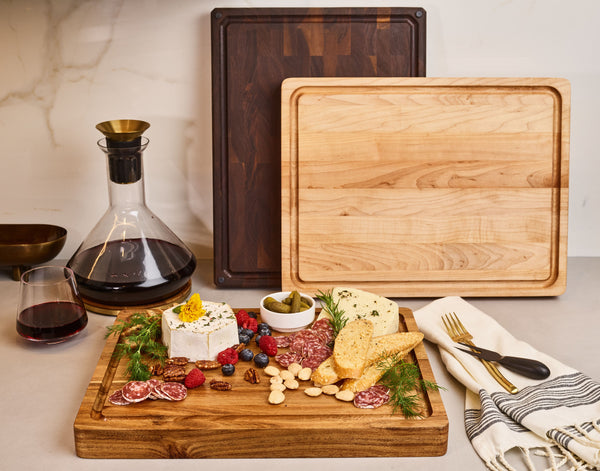Article: What’s the Best Wood for a Cutting Board?

What’s the Best Wood for a Cutting Board?
So you’ve decided to invest in a wooden cutting board—yay! Now the question is, what’s the best wood to choose for your cutting board? Selecting one is no easy task given all the information and resources available out there, but not to worry, we’ve done all the heavy lifting. We want to explore four common woods used and how to pick the best cutting board for you and your needs. Let’s dig in!
Quick note: Janka hardness scale tests resistance to denting and wear by measuring the force required to embed an 11.28 mm diameter steel ball halfway into a sample of wood.
TL;DR: Choosing the Right Wood for You
There’s no one-size-fits-all answer when asking what is the best wood for cutting boards. It all comes down to how you cook, how often you chop, and how much upkeep you’re willing to do. Here’s a quick summary:
|
Wood Type |
Best For |
Knife-friendliness |
Maintenance |
Price Point |
|
Acacia |
Beginners, light use |
Moderate |
Low |
$ |
|
Teak |
All skill levels |
Good |
Low |
$$ |
|
Maple |
Everyday use, durability |
Great |
Medium-high |
$$ |
|
Walnut |
High-end look, moderate to heavy use |
Excellent |
High |
$$$ |
Acacia Wood Cutting Board: Sustainable and Budget-Friendly
Hardwood | Janka Hardness: 1750

Indigenous to Australia, acacia can grow in various areas, including Africa, Europe, and Asia. It’s highly coveted for its ability to thrive in multiple climates, making it a popular choice for those looking for sustainable wood materials.
Pros:
-
Lightweight and easy to handle
-
Affordable option
-
Fast-growing, sustainable species
-
Available in FSC-certified options
-
Low maintenance compared to other hardwoods
Cons:
-
Hardness can dull knives faster than softer woods
Best For:
-
First-time cutting board owners
-
Budget-conscious buyers
-
Occasional to moderate kitchen use
-
Stylish charcuterie boards
If you're just starting out, our acacia boards are a solid, eco-friendly choice.
Teak Wood Cutting Board: Moisture-Resistant and Striking
Hardwood | Janka Hardness: 1155

Indigenous to Asia and abundantly grown in Thailand and Malaysia.
Pros:
-
Natural oils make it moisture-resistant
-
Gentle on knives
-
Less prone to scarring
-
Requires minimal upkeep
-
Unique grain variations for a beautiful presentation
Cons:
-
Slightly more expensive than Acacia or Maple
Best For:
-
All skill levels
-
Cutting juicy fruits, veggies, or carving meats
-
Daily use and hosting/serving
All of our teak boards strike a perfect balance between function and flair.
Maple Wood Cutting Board: The All-Rounder Workhorse
Hardwood | Janka Hardness: 1450

Indigenous to North America. As a result, most Maple cutting boards are made right here in the USA.
Pros:
-
Incredibly durable and long-lasting
-
Gentle on knives
-
Resists scarring better than Acacia or Teak
-
Widely available in FSC-certified varieties
Cons:
-
Requires frequent oiling to avoid stains and drying out
Best For:
-
Home cooks who want a reliable, long-term cutting board
-
Moderate to heavy daily use
-
Those ready to care for their board properly
Invest in one of our maple boards if you want something that will go the distance.
Walnut Wood Cutting Board: Soft on Knives and Rich in Color
Hardwood | Janka Hardness: 1010

Indigenous to North America. As a result, most Walnut cutting boards are made right here in the USA.
Pros:
-
Gentlest on knives
-
Rich, dark tones add visual appeal
-
Naturally stain-resistant
-
Sourced predominantly in the USA
Cons:
-
Highest cost of the four
-
Requires more care and oiling
Best For:
-
Experienced cooks or chefs
-
Anyone using high-end knives
-
Statement pieces or elegant kitchen setups
-
Moderate to heavy use, especially with end grain boards
Walnut boards are an investment—but a beautiful and functional one.
What Makes a Good Cutting Board Wood?

When it comes to choosing the best wood for cutting boards, several factors come into play. It’s not just about looks—it’s about performance, longevity, and care.
-
Hardness is one of the most important qualities to consider. Too hard (looking at you, bamboo and glass), and your knives will suffer. Too soft, and you’ll be left with deep scars and a worn-out board. The sweet spot? Durable, knife-friendly hardwoods like maple, walnut, acacia, and teak.
-
Grain type also affects performance. Tight, closed grains help keep moisture out—making your board more sanitary and longer-lasting. Open-grained woods can trap liquids and bacteria. No thanks.
-
Maintenance is another big factor. All wood boards need oiling—but some make it easier. Teak and acacia are lower-maintenance champs. Maple and walnut need a bit more love, but reward you with top-tier performance.
End Grain vs. Edge Grain—What’s the Difference?
No matter if you’re eyeing a maple wood cutting board or a walnut wood cutting board, how it’s constructed is just as important as the type of wood. That’s where end grain and edge grain come in.
-
End grain cutting boards are made by arranging wood so the ends (the “growth rings”) face up. Think of it like chopping into a bundle of toothpicks—the knife goes between the fibers instead of across them. This design makes the board self-healing, much gentler on knives, and more durable over time.
-
Edge grain boards are no slouch either. They’re built from horizontal wood slices, making them more budget-friendly and lightweight—perfect for daily use without sacrificing strength.
Cutting Board Materials to Avoid
-
Bamboo: Surprising to most people, bamboo is actually grass, not wood. It’s not nearly as durable and is harder than any wood on our list, making it a foe to your knives and the environment. In addition, bamboo fibers are prone to splintering and fraying, which makes the board more vulnerable to bacterial growth and stains.
-
Plastic: Plastic cutting boards can develop deep scarring and gouges over time, which may trap bacteria if not cleaned thoroughly. These grooves can also release tiny microplastics during use, which may transfer to your food. Research suggests the average person could inadvertently consume a small amount of microplastics each year, with cutting boards being one potential source.
-
Glass: The least ideal cutting board material out there. It will quickly dull any knife and easily becomes slippery, which can lead to all kinds of accidents.
